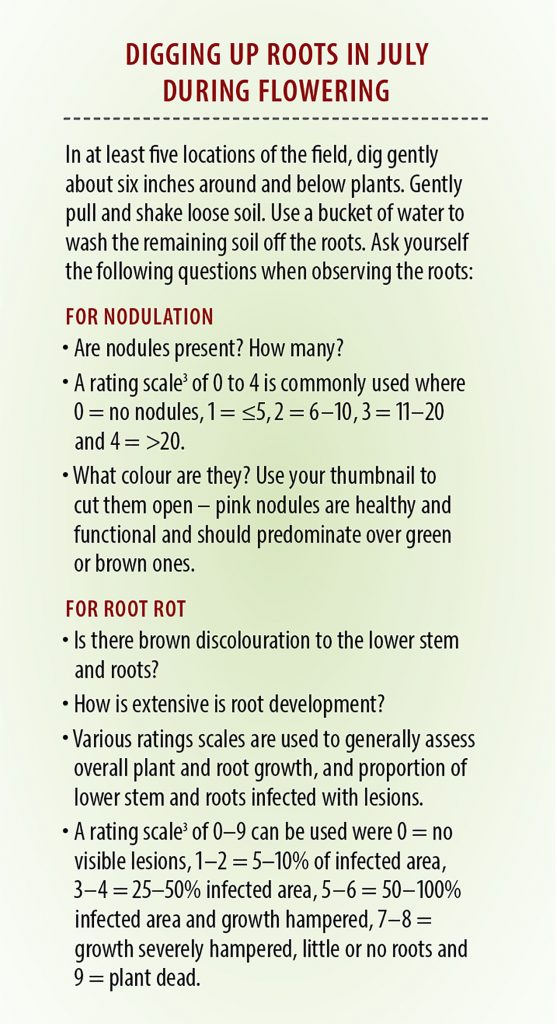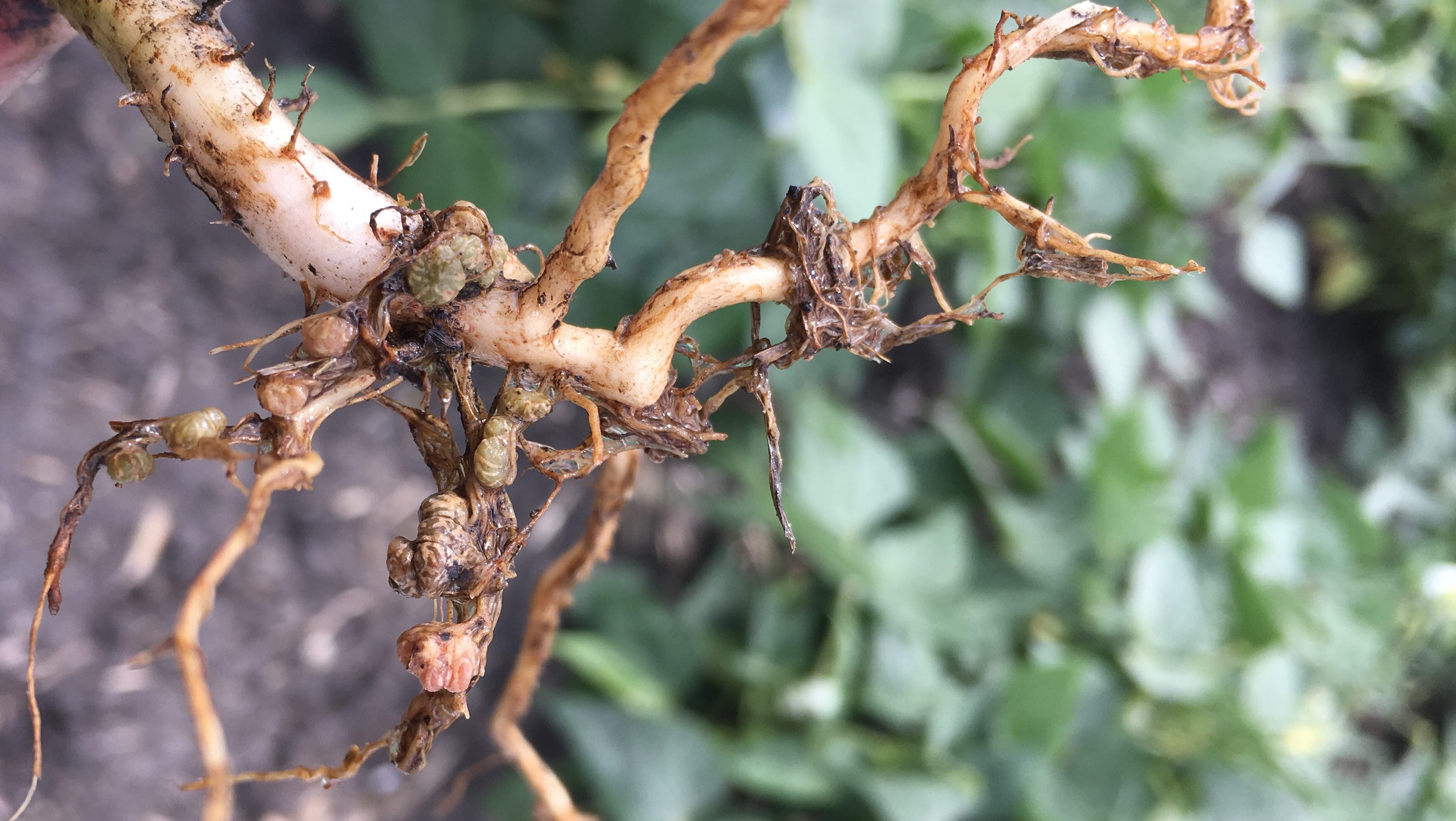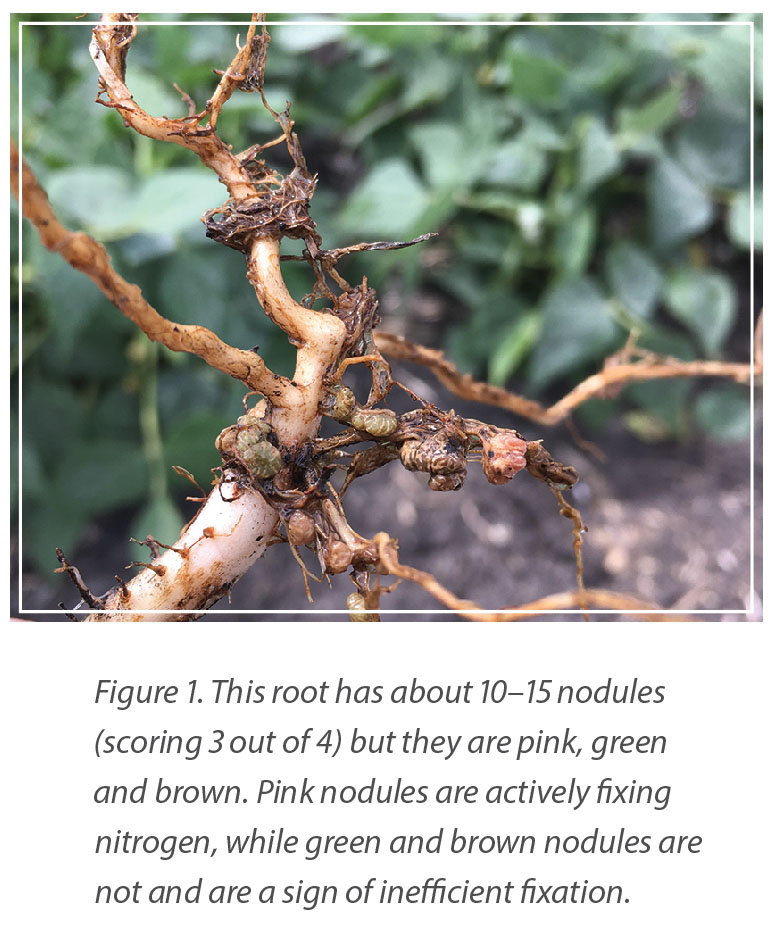An update from the soybean and pulse agronomy lab
Kristen P. MacMillan, MSc, PAg, Research Agronomist, Department of Plant Science, University of Manitoba
DIGGING UP ROOTS… is this part of your routine crop scouting? You could be counting nodules on soybean roots or checking for clubroot in canola, but what about other crops and conditions?
Digging up roots and inspecting them can be just as valuable as observing the crop above ground. Plant roots form an extensive network with soil, interacting with microbes, water and nutrients to produce biomass and yield.
We should ask ourselves — how are they functioning? Can our management system improve them?
In the soybean and pulse agronomy research lab, we are studying nitrogen, preceding crop and residue management in dry beans at Carman and Portage. Digging up roots is standard protocol for collecting data on nodulation and root rot to help explain research results.
Here’s how you can make observations about dry beans in your fields.
RESEARCH BACKGROUND
Nitrogen fertilization at an average rate of 60 lbs N/ac is standard practice for dry beans in Manitoba. Dry beans are managed like a non-legume crop in most production regions because they are inefficient at producing their own nitrogen (N).
On average, they acquire <45% of their N requirements through biological fixation (1), which is a particularly intricate process in dry beans and dependent on factors such as environment, market class, variety and inoculant. Our current N recommendations are based on research from the early 2000s — what are N dynamics and requirements in dry beans today?
In 2017, a dry bean nitrogen fertility study was established at Carman and Portage to determine the optimum N rate for Windbreaker pinto beans and T9905 navy beans. To date, three site-years have evaluated rates of 0, 35, 70, 105 and 140 lbs of applied N/ac.
Interestingly, the only statistically significant yield response is to the highest rate of N and when return to N ($/ac) is calculated, no N fertilizer addition is economical.
Another experiment evaluating the effect of preceding crop (wheat, canola, corn or pinto beans) and residue management (tilled vs. direct seed) on pinto bean production was also established. Both of these studies have contributed to interesting observations that will advance our dry bean production systems in Manitoba and western Canada.
ROOT NODULES
Pinto and navy beans start flowering 45–60 days after planting which usually falls during the second week of July. This is also the time you are likely weighing the decision of a fungicide application, which can be aided by scouting just prior to flowering for observations on the plant canopy and soil moisture conditions.
Digging up roots and checking for nodulation should be done after that — during flowering through early pod formation. The goal is to provide a general indication of whether or not functional nodulation is occurring and the severity of root rot. Identifying nodule presence and function is a starting point for future nitrogen management decisions.
The majority of dry bean farmers are not scouting for or accounting for nodulation, and this makes sense since they are a fertilized crop and inoculants are not used (previous research has supported these management decisions). However, based on our current research evaluating nitrogen management and studying dry beans in general, we should re-visit this.
In dry beans, nodulation and root rot rating scales are not correlated to productivity or yield but provide a relative indication of performance. For example, higher nodulation scores and good colour equals greater potential for biological nitrogen fixation (Figure 1).
Higher root rot scores, on the other hand, indicate reduced root growth that is likely limiting resource uptake and yield potential. Since you are likely checking nodulation in a field that was fertilized, dry beans are less likely to invest energy into forming nodules. So don’t be surprised if you don’t find any, and be pleasantly surprised if you do!
The rhizobia or N-fixing bacteria required to form nodules on dry bean roots is Rhizobium phaseoli — we usually introduce crop-specific rhizobia to the soil through inoculants but dry bean rhizobia is native to our soils, and may already exist in your fields. For example, in the nitrogen fertility experiment (seed was not inoculated), nodules were present in both navy and pinto beans at two out of three site-years, and the number of nodules was reduced as N rate increased. The overall scores were relatively low (<2 out of 4) which could be related to the dry conditions, but begs the question “is nodulation impacting their response to added nitrogen?”.
Inoculants have been tested in the past with little success and have not been widely commercially available. This past extension season, however, I connected with two companies and will be testing two bean inoculants on pinto, navy and black beans in a new experiment at Carman this year.
ROOT ROT
You may not find nodules, but you will probably find root rot. Over the past five years, root rot has been found in 100% of surveyed fields in Manitoba (2), although the incidence (% plants affected) and severity of affected plants varies (Figure 2 and 3).
Results from the 2018 preceding crop and residue management experiment show that the crop preceding dry beans affected root rot severity but residue management did not. Beans following beans and wheat had more severe root rot (2.8 out of 9) than beans following corn (2.5 out of 9) while beans following canola had a similar average score (2.7 out of 9) to all other residue types.
That being said, overall root rot scores were relatively low — pathologists consider a severity of greater than four out of nine to limit yield, which is when symptoms are present on 50% or more of the root system. Depending on the year, 30–93% of surveyed fields have a mean root rot score of >4, making root rot a major cause of yield loss in Manitoba dry beans.
Keep in mind that root rot can attack throughout the season and should be part of regular crop monitoring — this mid-season assessment may not take into account seedlings that were lost to seedling blight or damping off earlier in the season.
What root rot pathogen is present? This is nearly impossible to identify with visual observation but it is most likely Fusarium spp. Looking again at the annual survey results, Fusarium spp. are detected in 100% of surveyed fields, followed by a much lower occurrence of Rhizoctonia and Pythium.
There is currently no complete resistance to root rot in dry beans, but screening among AAFC pathology groups is ongoing in collaboration with the dry bean breeding program at Morden. At this point, if you find severe root rot in your field, consider bean field history, seed quality, fungicide seed treatment, environmental conditions and management practices that promote optimal growth.
Follow along with our research results as you evaluate your dry bean fields and tag me on Twitter (@kpmacmillanUM) with your root observations.
DIGGING UP ROOTS IN JULY DURING FLOWERING
In at least five locations of the field, dig gently about six inches around and below plants. Gently pull and shake loose soil. Use a bucket of water to wash the remaining soil off the roots. Ask yourself the following questions when observing the roots:
FOR NODULATION
- Are nodules present? How many?
- A rating scale of 0 to 4 is commonly used where:
- 0 = no nodules,
- 1 = ≤5,
- 2 = 6–10,
- 3 = 11–20,
- 4 = >20.
- What colour are they? Use your thumbnail to cut them open – pink nodules are healthy and functional and should predominate over green or brown ones.
FOR ROOT ROT
- Is there brown discolouration to the lower stem and roots?
- How is extensive is root development?
- Various ratings scales are used to generally assess overall plant and root growth, and proportion of lower stem and roots infected with lesions.
- A rating scale (3) of 0–9 can be used where:
- 0 = no visible lesions,
- 1–2 = 5–10% of infected area,
- 3–4 = 25–50% infected area,
- 5–6 = 50–100% infected area and growth hampered,
- 7–8 = growth severely hampered, little or no roots,
- 9 = plant dead.
References
1 Walley, F.L., G.W. Clayton, P.R. Miler, P.M. Carr and G.P. Lafond. 2017. Nitrogen economy of pulse crop production in the Northern Great Plains. Agron. J. 99:1710-2728.
2 McLaren, D. (editor). Annual report of diseases of field bean in Manitoba (2014-2018). Can. Plant Dis. Surv. Vol 94-98.
3 Chang, K.F., R.L. Connor, S.F. Hwang, H. U. Ahmed, D.L. McLaren, B.D. Gossen and G.D. Turnbull. 2013. Effects of seed treatments and inoculum density of Fusarium avenaceum and Rhizoctonia solani on seedling blight and root rot of faba bean. Can. J. Plant Science 94: 693-700.




